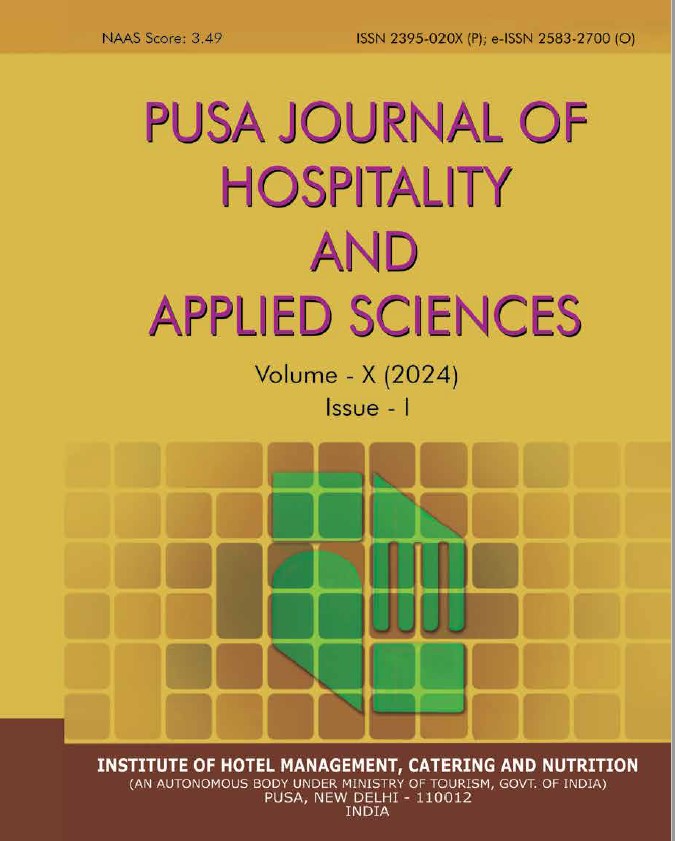Pilgrimage Satisfaction Of Religious Event-Nanda Devi Raj Jaat 2014 Uttarakhand
Keywords:
Tourism, Religious event, Pilgrim Satisfaction, Nanda Devi RajAbstract
Background: Pilgrimage to sacred place as an act of religious devotion is an age old tradition, followed by religions all over the world and especially in India. Pilgrim satisfaction of religious events indicates the quality of services rendered by the event organizers, prevents negative evaluation and unfavourable word of mouth of the events. Considering a need for understanding the pilgrim satisfaction of a religious event, a study was organized. Objective: The objective of the study include measuring pilgrim satisfaction & identifying key factors that influence pilgrim satisfaction and to know their relative importance. Method: Nanda Raj Jaat Uttarakhand 2014 was taken as case study for this paper. About 200 pilgrims who visited event were interviewed as a sample with a structured questionnaire. Results: Results indicate that providing basic facilities to the pilgrims would be single most important factor influencing the satisfaction. Conclusion: The study concluded that arrangements at the event Nanda Raj Jaat 2014 have met the expectations of the pilgrims moderately.
References
Anderson, E.W. Fornell. C. & Lehmann. R.R. (1994). Customer satisfaction, market share, and profitability: findings from Sweden. Journal of Marketing. 58 (January) 53-66. 2. Andreassen, T.W. (2000). Antecedents to satisfaction with service recovery. European Journal of Marketing. 34 (1 & 2). 156-175.
Anton, J. (1996). Customer Relationship Management: Making Hard Decisions with Soft Numbers (pp.432-412) New Jersey. Prentice Hall.
Baker, D. & Crompton. J. (2000). Quality, satisfaction and behavioural intentions, Annals ofTourism Research. 27 (3). (p.p 785-804).London, England: Sage.
Boulding, W., Staelin, R. Kalra, A. & Zeithaml. V.A. (1993). A dynamic process model ofservice quality: from expectations to behavioural intentions. Journal of Marketing Research. 30 (February). 7-27.
Cho. B. (1998). Assessing tourist satisfaction. Tourism Recreation Research, (pp. 47-54) New York :USA
Choi, Y. Tat & Raymond, Chu. (2000). Level of satisfaction among Asian and Western travelers. International Journal of Quality and Reliability Management. pp.116 – 131. 8. Cronin , J.J. Jr & Taylor S.A. (1992). Measuring Service Quality: A Re-examination and Extension. Journal of Marketing. 56. 55 – 68.
Danaher, P.J. & Arweiler, N. (1996). Customer satisfaction in the tourist industry: A case study of visitors to New Zealand. Journal of Travel Research.pp.83-93
Engel, J.F., Blackwell, R.D. & Miniard P.W. (1990). Consumer Behaviour, 6th Edition. Illinois.Dryden Press.
Fornell, C. (1992). A national customer satisfaction barometer: the Swedish experience . Journal of Marketing. 55 (January). 6-21.
Foster, D. (2004). Measuring Customer Satisfaction in the Tourism Industry. Paper presented at Third International and Sixth National Research Conference on Quality Management, The Centre for Management Quality Research, RMIT University.
Goodall, B. & Bergsa J. (1990). Destinations: as marketed in tour operators’ brochures. in Ashworth, G. and Goodall, B. (Eds.), Marketing Tourism Places (pp. 211-221) London, Routledge: England
Gupta, V. (1999). Sustainable Tourism: Learning from Indian Religious Traditions. International Journal of Contemporary Hospitality Management. 11 (2/3). 91 – 95. 15. Gyte, D. & Phelps A. (1989). Patterns of destination repeat business: British tourists in Mallorca, Spain. Journal of Travel Research. 24-28.
Hair, J. E., Jr, Roph, E. A., Ronald, L. T. & William, C. B. (1998).Multivariate Data Analysis, Fifth Edition, New Jersey: Prentice hall International Inc
Hudson S. and Shepard G.W.H. (1998). Measuring service quality at tourist destinations: an application of importance-performance analysis to an alpine ski resort (pp.342-349) New Jersey:USA
Ibrahim, E. E. & Gill, J. (2005). A positioning strategy for a tourist destination, based on analysis of customers’ perceptions and satisfactions. Marketing Intelligence and Planning (pp 172 – 188). Malden, MA: Blackwell.
Incredible India Tourism Report. (2013). http://www.incredibleindia.org/ report/ tourismreport2013.html
Johnson, M.D., Anderson, E.W. & Fornell C. (1995). Rational and adaptive performance expectations in a customer satisfaction framework. Journal of Consumer Research. 128-140.
Kozak, M. & Remmington, M. (1998). Benchmarking; Destination Attractiveness and Small Hospitality Business Performance. International Journal of Contemporary Hospitality Management.184 – 189.
Kozak, M. (2001). Repeaters’ behaviour at two distinct destinations. Annals of Tourism Research. Malden, MA: Blackwell.
Malhotra, N. (2002). Marketing Research: An applied orientation. New Jersey. Prentice- Hall Nunnally C. J. (1978). Psychometric Theory. New York. Mc Graw Hill
Oliver, R.L. (1993). Cognitive, affective, and attribute bases of the satisfaction response .Journal of Consumer Research. 418-30.
Pizam, A. & Milman, A. (1993). Predicting satisfaction among first time visitors to a destination by using the expectancy disconfirmation theory. International Journal of Hospitality Management. 197-209.
Pizam, A. & Taylor, E. (1999). Customer satisfaction and its measurement in hospitality enterprises. International Journal of Contemporary Hospitality Management. 326-339 27. Ryan, C.& Cliff A. (1997). Do travel agencies measure up to customer expectations? An empirical investigation of travel agencies’ service quality as measured by SERVQUAL. Journal of Travel and Tourism Marketing. 1-31.
Spreng, R., MacKenzie, S.& Olshavsky R. (1996). Re-examination of the determinants of consumer satisfaction. Journal of Marketing. pp. 15-35.
Swarbrooke, J. (1995). The Development and Management of Visitors Attractions, Butterworth – Heinemann, Oxford publishers
Tse, D.K. & Wilton, P.C. (1988). Model of consumer satisfaction formation: An extension. Journal of Marketing Research. pp. 204-212.
Vavra, T.G. (1997). Improving Your Measurement of Customer Satisfaction: A Guide to Creating. Milwaukee, WI. ASQ Quality Press. PP. 430-440.
Vitterso, J.,Vorkinn, M., Vistad, O.I. & Vaagland J. (2000). Tourist experiences and attractions.Annals of Tourism Research .pp 432 – 450. Toronto, ON: McGraw Hill Ryerson. 33. Westbrook, R.A. & Oliver, R.L (1981). The Dimensionality of Consumption Emotion Pattern and Satisfaction. eview of consumer satisfaction in Zeithaml, V.A. (Ed.), Review of Marketing. Chicago. American Marketing Association.




